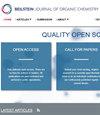涉及超价碘盐的无过渡金属芳基化反应的最新进展。
IF 2.2
4区 化学
Q2 CHEMISTRY, ORGANIC
Beilstein Journal of Organic Chemistry
Pub Date : 2024-11-13
eCollection Date: 2024-01-01
DOI:10.3762/bjoc.20.243
引用次数: 0
摘要
在过去的二十年里,二迭碘鎓盐作为芳基化试剂得到了广泛认可。这些盐的对称和不对称形式在各种有机合成中都是有效的亲电芳基化试剂。特别是在无金属条件下,二芳碘鎓在 C-C 和碳-杂原子键形成中的应用进一步提高了这些试剂的受欢迎程度。在本综述中,我们将集中讨论涉及碳和其他杂原子的各种芳基化反应,包括在无任何金属催化剂条件下的重排反应,并总结过去五年中取得的进展。本文章由计算机程序翻译,如有差异,请以英文原文为准。
Recent advances in transition-metal-free arylation reactions involving hypervalent iodine salts.
Diaryliodonium salts have become widely recognized as arylating agents in the last two decades. Both, symmetrical and unsymmetrical forms of these salts serve as effective electrophilic arylating reagents in various organic syntheses. The use of diaryliodoniums in C-C and carbon-heteroatom bond formations, particularly under metal-free conditions, has further enhanced the popularity of these reagents. In this review, we concentrate on various arylation reactions involving carbon and other heteroatoms, encompassing rearrangement reactions in the absence of any metal catalyst, and summarize advancements made in the last five years.
求助全文
通过发布文献求助,成功后即可免费获取论文全文。
去求助
来源期刊
CiteScore
4.90
自引率
3.70%
发文量
167
审稿时长
1.4 months
期刊介绍:
The Beilstein Journal of Organic Chemistry is an international, peer-reviewed, Open Access journal. It provides a unique platform for rapid publication without any charges (free for author and reader) – Platinum Open Access. The content is freely accessible 365 days a year to any user worldwide. Articles are available online immediately upon publication and are publicly archived in all major repositories. In addition, it provides a platform for publishing thematic issues (theme-based collections of articles) on topical issues in organic chemistry.
The journal publishes high quality research and reviews in all areas of organic chemistry, including organic synthesis, organic reactions, natural product chemistry, structural investigations, supramolecular chemistry and chemical biology.

 求助内容:
求助内容: 应助结果提醒方式:
应助结果提醒方式:


